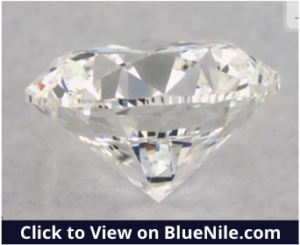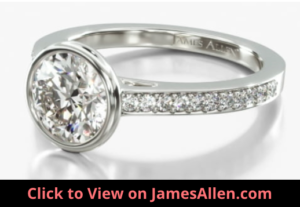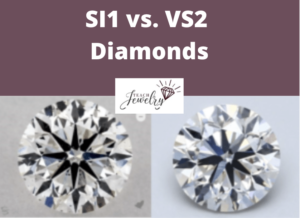
A diamond’s clarity grade is based on the extent to which inclusions affect its quality.
Two categories on the clarity scale are SI (slightly included) and VS (very slightly included). There are two grades within each: SI1, SI2, VS1, and VS2.
The main difference between SI1 and VS2 diamonds is that SI1 diamonds often have a higher number of inclusions with a greater impact on the gem’s appearance, durability, and brilliance. VS2 diamonds typically have smaller inclusions that aren’t visible without magnification, so they sell for a higher price.
We’ll compare SI1 versus VS2 diamonds across their most important characteristics, including:
- Overviews of each
- Five differences
- What they have in common
- How to choose which is right for you
What is an SI1 Clarity Diamond?
SI1 clarity diamonds have noticeable inclusions when viewed at 10x magnification, but they’re sometimes invisible to the naked eye.
SI1 is seventh lowest position in the GIA clarity scale. It’s one grade below VS2 and one above SI2. So the inclusions are slightly more impactful than the former but less than the latter.
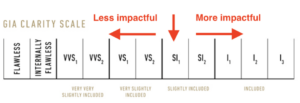
An SI1 clarity grade isn’t referring to a specific number or type of inclusion. It could have several twinning wisps, a feather, and clouds and still earn the same grade as one with only bruises and needles.
For example, check out this SI1 diamond from James Allen, where I bought my wife’s engagement ring.
At a glance, it appears eye-clean. But upon closer examination, you’ll notice white feathers in several places.
Compare it to this diamond, which earned the same grade. Black spots scattered across the table are immediately noticeable.
It may appear that way when viewed in a normal setting as well.
This demonstrates how the SI1 clarity grade is only a starting point in understanding how the imperfections affect its appearance.
By viewing the certificate and high-resolution images, you can identify how the inclusions impact its appeal.
What is a VS2 Clarity Diamond?
VS2 is the sixth highest position on the clarity scale. It sits above SI1 and below VS1.
Similar to SI1, a VS2 diamond doesn’t have an exact number of inclusions. It may contain several small pinpoints and a few clouds or an etch channel and cavity.
If the inclusions are difficult to spot with the naked eye, but generally apparent at 10x magnification, it may earn the VS2 clarity grade.
As an example, this VS2 diamond features crystals, indented naturals, and naturals.
Another diamond could include these same inclusions but earn a higher or lower grade, depending on their overall effect.
It’s often difficult to identify the differences between clarity grades that are next to each other on the GIA scale, such as VS1 and VS2.
In fact, two trained gemologists can provide unique grades for the same diamond, which emphasizes the importance of a reliable report.
How are SI1 and VS2 Diamonds Different?
1. Occurrences of Inclusions
Although clarity grades aren’t referring to an exact number of inclusions, SI1 diamonds often have a higher number of flaws compared to VS2 diamonds.
That’s because if all the blemishes are the same size and type, the one with fewer occurrences will earn a higher clarity grade.
A significant number of inclusions has a stronger likelihood of becoming visible to the naked eye and affecting its durability.
Several occurrences of small twinning wisps, clouds, or etch channels can add up to have a noticeable impact on its appeal.
As examples, let’s compare this SI1 diamond and this VS2 diamond.
The SI1 diamond has six types of inclusions:
- Twinning wisp
- Feather
- Crystal
- Indented natural
- Needle
- Natural
Here’s an image of the clarity characteristics plot from the GIA report.
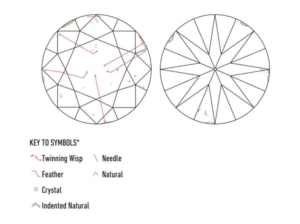
The VS2 diamond only has three types of inclusions. There are seven total instances.
But there are plenty of exceptions to this rule.
This round-cut earned VS2 but has five types of clarity characteristics.
In general, I recommend choosing one with fewer inclusions, but the size and type are also important considerations. Your goal is to find a diamond within your budget that appears flawless without magnification.
2. Visibility of Flaws
Most buyers aren’t concerned with the details of a diamond’s inclusions and its clarity grade. Instead, they pay attention to whether its blemishes are visible to the naked eye.
It’s known as an eye-clean diamond.
VS2 diamonds that weigh less than two carats rarely have visible inclusions when viewed in a normal setting.
That’s why they’re a popular choice for engagement ring diamonds.
The center diamond commands all the attention, so buyers don’t want to see black spots scattered across its table or a large feather extending down the pavilion.
Check out this VS2 diamond from James Allen.
When placed next to a flawless one (below) you can’t tell the difference, even with high-quality images.
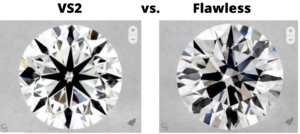
All else being equal, it will cost less than half of one that earns a flawless grade, so it’s an effective way to save on the cost of your diamond.
SI1 diamonds between one and two carats are less likely to be eye-clean.
It’s important to view the diamond in person or through high-resolution images. You’ll discover whether there are too many flaws to hide.
For example, you might notice the image shows dozens of black spots scattered across the table. It’s likely those are visible without magnification.
3. Durability
The effects of inclusions on SI1 and VS2 diamonds aren’t limited to visual appeal. They also impact durability.
Inclusions represent weak points in a diamond’s structure. It’s more likely to chip if it’s hit or dropped on an area with an inclusion.
This is especially true if the flaw is located on a sharp corner, such as those found on a princess cut. These points, and ones on marquise and pear cuts, are already vulnerable.
Combined with inclusions like those in an SI1 diamond, it’s important to have a quality setting that protects these areas.
For example, bezel settings wrap the diamond in a ring of metal.
Check out the example below in 14k white gold.
It’s the setting that best secures the diamond, but it isn’t a necessity for SI1 or VS2 diamonds.
4. Brilliance and Fire
The reason VS2 diamonds are more brilliant than SI1 diamonds is because inclusions can distort the way white light enters and exits a diamond.
While cut is the most important factor, too many imperfections can result in a lack of sparkle.
Fire refers to the flashes of colored light that radiate from a diamond. Inclusions impact fire the same way as brilliance.
This is another reason that when buyers compare VS2 versus SI1 diamonds for engagement rings, they often choose the former.
5. Cost
Buyers pay a premium to avoid inclusions. So if all else is equal, each step up the clarity scale increases its price.
VS2 diamonds are more expensive than SI1 diamonds.
To help understand how prices change depending on the clarity grade, I examined prices for 116 diamonds from James Allen.
They all had the following qualities:
- Carat weight: 1.00
- Color: F
- Cut: Very good
The ones with SI1 clarity sold for an average of $4,328, with a range of $3,890-$4,790.
Ones that earned a VS2 grade sold for $5,197 on average. The range was $4,280-$6,220.
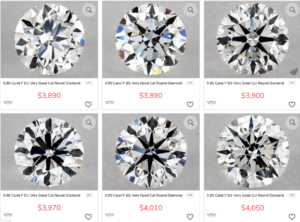
That’s a 20 percent higher price for a VS2 diamond compared to an SI1 diamond.
This follows the general rule that you can expect a 10-20 percent increase for every move up the scale.
When you’re moving from one section to another, like SI versus VS, it’s typically toward the higher end of that range.
This further emphasizes the value of finding an eye-clean diamond with lower clarity. You’ll avoid the premiums of high clarity grades while still selecting a quality diamond.
What do They Have in Common?
The common trait between SI1 and VS2 diamonds is their use in engagement rings. In fact, both are a popular choice as the center diamond because they can appear eye-clean while offering significant cost savings compared to higher clarity grades.
The key is viewing the diamond in person or through high-resolution images online. You can’t identify whether it’s clean solely based on the report, especially for these two grades.
I recommend starting your search for engagement ring diamonds less than one carat at SI1. If you find an eye-clean gem, it might offer tremendous value.
For example, the image below is of an SI1 diamond that doesn’t show imperfections in high resolution.
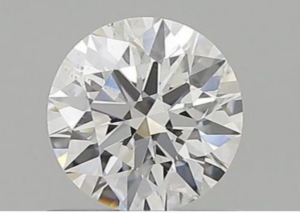
It’s certainly a candidate for a place as the main diamond in an engagement ring.
But don’t be afraid to work your way up the scale to VS2 because the price jump isn’t significant in some cases.
In fact, for my wife’s engagement ring, I moved up one more grade to VS1 because it had all the other qualities I wanted.
Unless the diamond is heavier than two carats, you’ll likely pay more than necessary if go beyond VS1 in your search for an eye-clean diamond.
Should You Choose an SI1 or VS2 Diamond?
Choosing between SI1 versus VS2 clarity diamonds involves understanding all the ways its clarity grade affects its appeal, from its brilliance and durability to price and appearance.
Here are some tips to help you decide.
An SI1 diamond might be right for you if:
- You want to save on the diamond’s cost and instead put that savings toward its carat weight, color, or cut grade
- You’ve viewed the diamond in person or through high-resolution images and are confident it’s eye-clean
- You’re searching for a diamond smaller than one carat
Consider a VS2 diamond if:
- You want confidence it’s eye-clean, even if it’s between one and two carats
- You’re interested in a diamond that could appear identical to a flawless one, even though it’s less than half the price
- You’re choosing a fancy shape that doesn’t hide inclusions as well as round-cut diamonds
By pairing each with different types of settings, you’ll create the perfect diamond ring.

Jacob Clarke
Jacob Clarke is the founder of TeachJewelry.com.
He earned an Applied Jewelry Professional Diploma from the Gemological Institute of America (GIA) and now brings you essential information about diamonds, settings, and more.
Jacob has consulted with leading jewelry brands, and his work has been cited in Clean Origin, Diamond Nexus and industry publications.
He's also a member of the International Gem Society.
He enjoys discussing jewelry with readers, so contact him with any questions at jacob.clarke@teachjewelry.com.

